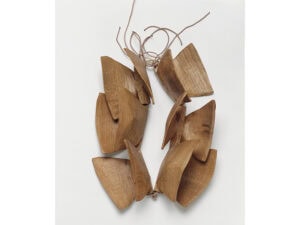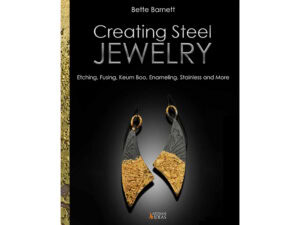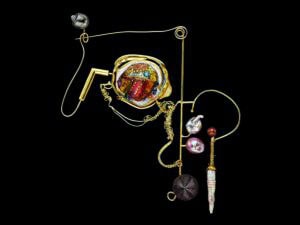This year’s Society of North American Goldsmiths’ (SNAG) conference “Meta-Mosaic“ was held in May in Toronto, Canada. It was co-chaired by Paul McClure of George Brown College and Melanie Egan of the Harbourfront Centre, an “innovative not-for-profit cultural organization that creates events and activities of excellence.”[i] The Harbourfront Centre boasts a metals studio in its own craft department hosting “six to seven full-time artists-in-residence”[ii] and runs a program of beginner and intermediate jewelry courses. George Brown College, a Toronto-based tertiary training facility prides themselves on preparing “workplace-ready graduates,”[iii] and as such, their jewelry course, a part of their School of Fashion Studies, offers “Jewelry programs [that] prepare you to work in the fine jewelry industry.”[iv] With the focus of the conference shaped by these organizers and organizations, it was an interesting year to go into the conference with an investigation topic already mapped—namely, how do the conference attendees articulate their relationship with skill?
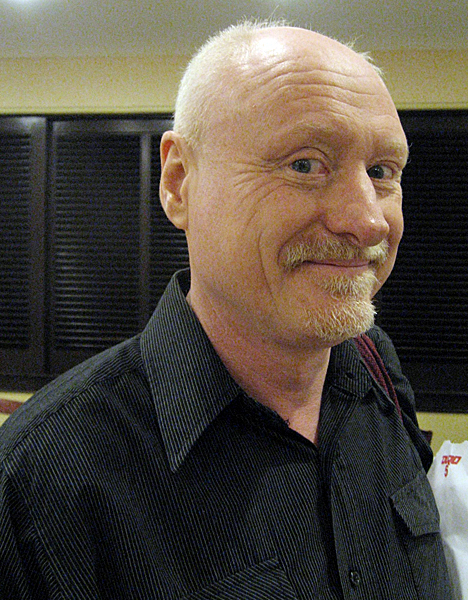
The responses I received to my question varied, but all were arrayed along a fairly well defined spectrum. One end was an argument for a level of material knowledge and technical skill so high that these, and not an overarching design or concept, defined the output of the maker. This stance was best exemplified by a presentation on day two in the conversation between well-known Canadian maker and teacher Charles Lewton-Brain and Alan C. Elder. The artisan that came through this question and answer discussion was one clearly committed to material investigations, one for whom the process of metalsmithing is prized as both the means of conceiving and creating works.
Michael Belmore, another local artist, neatly encapsulated the other end of the spectrum in his presentation. He was the first to speak in the PechaKucha-style, midcareer artist talks. Dispensing with all but the sparest introduction, Belmore launched straight into a chronological presentation and examination of some recent works. He spoke conceptually and thematically about his finished pieces, and the ideas he was expressing through them. In some cases, he even touched on their life cycle and the audience reactions they garnered as well as on the intended or unintended consequences of their installation on a site or in a gallery. He mentioned his processes in passing, and in a perfectly aimed nod to his audience, made a joke about his large-format chasing work, saying that he resorted to repoussé only when he made a mistake, wryly undercutting the undeniably high level of skill displayed in his works. After this introduction (and despite some makers even claiming the contrary during their presentations) the dominance of craft terminology in the subsequent presentations was immediately noticeable. Process, materiality, and the studio were highlighted and conceptual content was often only given a glance.
It was clear from his presentation that Belmore learned and leveraged skills in service to his conceptual intent. In conversations with him after the conference, I sought further insight into his perceptions of the significance of skill within his practice, in which he stated that, “Skill is important. When things are done well, they seem effortless to the eye. Skill offers the easiest and possibly the best way to speak to the viewer … Skill is about capturing your voice in the object so that it can be shared easily.”[v] His materials and processes are planned in detail, as “they all have meaning, and they all talk to whatever issue I wish to imbue the object with.”[vi]

Freedom through Skill, Freedom from Skill
At this conference, my conversations with other artists, jewelers, object makers, and designers evinced a multiplicity of responses to the question of each maker’s relation with skill. Most of these conversations naturally veered toward matters of process and materiality, thus highlighting their importance to practitioners. This tendency illustrated the pervasiveness of craft thought amongst those in attendance.
The general consensus amongst my interviewees was that a base level of metalsmithing knowledge and skill is deemed necessary to create jewelry work. When noting to artist and writer Jillian Moore that this bias toward metals expertise came up time and again in my conversations, she said that “Some kind of expertise is what we are all interested in, and we have a traditional idea of what that expertise should be. There is a traditional model for training that kind of expertise that a lot of people work in.” When starting out, she mentioned that she found these traditional skills seductive, as it is easy to dazzle, to amaze, and to create wonder, and to produce a certain sense of opulence through the works so produced. For her practice now, however, she says “I’m interested in a different kind of wonder, so I take the patience that came with the traditional skillset and try to apply it to different things that give me the results that I want.”[vii]
For many of the artisans that I spoke to, the underlying assumption was that this level of skill is important in order to know how or when to acquire more skills. Then beyond that, there was often a higher expectation, where being well versed in a diverse range of skills was particularly prized. To summarize the words of educator and metalsmith Sean Macmillan, conceptual content is lent more legitimacy through skillful execution, when an artist understands the rules that they are breaking. In the same vein, Brian Ferrell likened metalsmithing to jazz, in that performers need to have a great understanding and skill in order to take their works in different directions.”[viii]
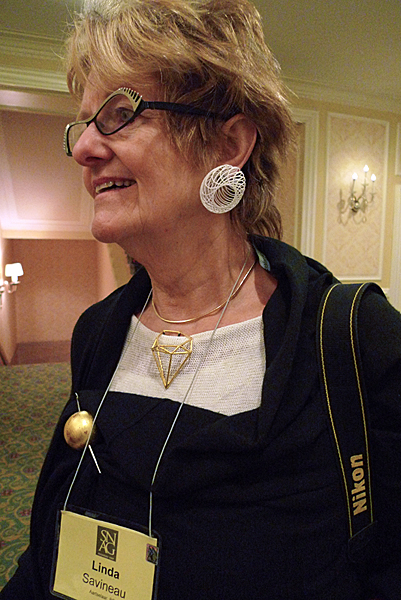
Interestingly, much of the work Savineau wore and all of the pieces she shared through the traditional SNAG first night pin swap were 3D printed. As a second-career artist, Savineau mentioned that she did not grow up with computers, but “is now pretty comfortable with them,” and that she had been introduced to 3D printing through SNAG conference attendance. She noted that part of the blessing of knowing, yet not having complete mastery of, this tool is that she enjoys the surprises she gets from the process. She acknowledges that with her limitations in computing skills, she is often party to accidental creative happenings, ones that would not have occurred if the process were completely in her control.[x]
Many makers made a case for the opposite, however, arguing for complete mastery of the skills used in their practice. Diane Reilly said this “allows you to express yourself fluidly with the material.” Reilly was also quick to point out that “skill and material aptitude allow you to be more fluid,”[xi] and to be “uninhibited by process.”[xii] A loss of inhibition in an effort to engage the subconscious, creative brain is understandably highly prized. In essence, that speaks to requiring a very high skill level, so as to cause the least amount of friction against burgeoning ideas.
And Skill Begat Skill
In the same conversation, Brian Ferrell, who began in metals but also creates furniture as well as being an educator, contributed that the “process of metalsmithing is so tangible … it allows you to explore new materials without prior knowledge.”[xiii] This idea, brought up time and again in my conversations, implies that owning a specific skill brings with it an implicit understanding of the limits and benefits of that skill in that material, and by proxy, a general understanding of similar processes in other materials. In effect, it begets a depth of understanding that can be engaged when cultivating skills in another arenas or when designing away from the workshop. It is a concept singled out by Juhani Pallasmaa in his book The Thinking Hand: “Mastering one craft helps the designer and architect to grasp the nuances of other crafts.”[xiv] This craft transference is seen as another important benefit of having what was often, and rather nebulously, described as ‘a base level of skill’.
In our conversation, Grace Hilliard-Koshinsky explained that while she had developed a repertoire of material knowledge, her intention for each piece she makes dictates the materials to be used and skills to be learned in order to create that work. In the course of developing new objects, she traces diverse ideas and thus works with diverse materials, and so at each turn she takes up the techniques required to resolve each as they dictate.
Hilliard-Koshinsky acknowledged that at the moment she is “pursuing steel,”[xv] and while she took pains to point out that she does not fit ideas to steel, she now “thinks” in steel owing to her creative immersion. In her view, having developed a mastery over this material—with it she is able to create hollow forms through the inflation techniques developed by mentor Elizabeth Brim—she now believes that she understands the implications of working in that material in a technical sense, according to its working materiality and more specifically why it works the way that is does.
This comment on the implications of steel precipitated further discussion on the wider ramifications of Hilliard-Koshinsky’s chosen material, and connected with a story from my past that involved experiencing how the massive iron ore trains in Port Hedland, Western Australia, have shaped that town geographically. This digression cast a new light on our use of the word “materiality.” The assumption that materiality and the implications of certain materials refers to their technical aspects and not to their historical nor cultural connotations seems to have been implied by the discussion of skill, as this was the only time this aspect of materiality came up in my discussions. It is possible that the word “skill” itself is loaded, especially for the group being interviewed, so its use consistently took these conversations in a particular direction.
Hilliard-Koshinsky uses this knowledge to her advantage to “wield it against type,” making realistic reproductions of soft things such as backpacks, duffel bags, and more recently, garments. Having these skills in her hands involves not only knowing how to create the object itself, but also having the skills needed to make the special tools required to fabricate the object. In effect, she leverages what knowledge she already has in order to analyze a problem and synthesize an entirely new solution in the form of a tool that did not exist before,[xvi] which can only be the product of skills she has already acquired. She says that these skills have thus allowed her to “develop a predictive sense, at least some of the time.”[xvii]
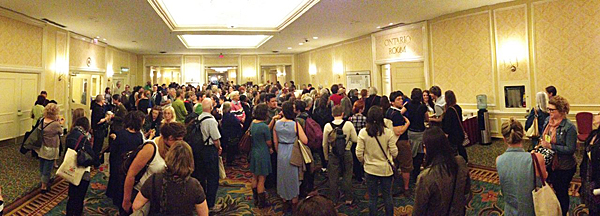
Overskill
Katja Toporsky neatly described the non-binary philosophy espoused by many makers, stating that skills are both an important starting point and acquirable on an as-needed basis. “It’s important to have a wide array of skills at your fingertips. It then becomes choice rather than necessity to choose one skill over another.”[xviii] And then, “My work is also very experimental, involving a vast array of materials I had to explore and acquire the skills to work with. Here, skill is more related to knowledge about the material’s properties, its history, and the meaning people associate with it.”[xix]
Tellingly, Toporsky is in agreement with Belmore and Macmillan, in that she, too, recognizes that skill is not an end in itself, but by the same token, “lack of skill is a distraction and diminishes the work, so I do make sure things are executed to a good standard.”[xx] She also admits to finding comfort in working with what she knows, saying “I prefer to employ skills that I feel at ease with—die forming, chasing and repoussé, fabrication—over certain others.”[xxi] But she is also self aware, avoiding the perils of virtuosity for its own sake. “I sometimes choose not to learn a skill to perfection,” says Toporsky. “For example, I use a lot of molds into which I cast a large variety of materials. While I know how a perfect mold is supposed to be made, I prefer the look of the imperfect. Pure virtuosity without thought plays no role in work, and maybe that’s the place where I veer off the trodden path of craft.”[xxii]
Leaning away from virtuosity for its own sake was also noted in the group conversation that took place between myself and Maria Eife, Brian Ferrell, Jera Rose Petal Lodge, and Sean Macmillan. It turned out to be a watershed moment for me, for it was on this fateful occasion that I learned the expression “technical vomit piece.”[xxiii] This is pretty much as it reads—a piece that uses a lot of difficult techniques purely for the challenge of being able to execute them in concert. The group dismissed such works, noting that when the primary function of a piece becomes to impress other makers—and the consensus was that this was the main function of such works—then the object’s primary (and dubious) claim to fame is to limit its audience to people who would be impressed by such displays. Thus, while the conversation pointed toward the idea that skill is very important, it did include design and conceptual skill. The conclusion was that if the work has no center, no reason for being, it would ultimately be a weaker work than one that has put this skill in service to an interesting idea.
Shorthands and Parochialism
Of course in that conversation, as well in many others I was party to during the conference, the point is that technical skills are present. The unspoken assumption underpinning all of the informal interviews I conducted, as well as many of the presentations I attended, was that in order to be a “good” maker, skills in metalsmithing are of primary importance. And hand-in-hand with that, in order for the work to be good, the technical skills of the maker had to be evident in the work itself in some fashion.
That the conversations I had about skill referred to hand skills and metals training as the basis from which all jewelry and object-making (conceptual or otherwise) arrives, while unsurprising in itself, is more telling in what it reveals about makers, and perhaps the dominant educational paradigm, in North America, and more specifically, what artisans here are comfortable talking about. Inferred by and revealed through these conversations, and aided in the way in which language, and particularly the language of craft, was used during the conference presentations, it is possible to conclude that the practice of making itself is the most important thing that the collective is attempting to communicate about, and not the concepts illustrated or the ideas communicated through it. It would seem that the main concern within the field is not what or why, but how an object is made.
There is dissatisfaction with this being the state of discourse, as evident in my conversation with Maria Eife and Jillian Moore, two artists whose works benefit from a broader definition of skill. Both of these artists acknowledged that excellence in traditional craft skills are of more importance to their sensibility and ethos than they are to the practical day-to-day of their practices. For them, a well-crafted object is still part of the desired outcome. However, because their jewelry uses new materials (laser-cut felt and 3D-printed nylon in the case of Eife and hand-painted layers of resin over polymer or foam in the case of Moore), they are often considered the outliers in what I have come to understand is a metal-skills-focused field in the US. Eife also suggested the lack of visible trace of her hand in her work somehow makes her practice less acceptable in certain circles. This perception sometimes changes, however, when people find out about her metalsmithing education. Both artists would like to see a shift in focus from technique or materiality toward greater acknowledgment of conceptual skill, as it is in concept that Eife and Moore wish to define their works. They have made specific skill and material choices, yes, but they have been made very deliberately in service to the ideas that they are trying to convey through their works.
Having been in discussion with students about their works at the conference, Moore called into question the thematic shorthand that has crept into American craft through a desire or need to engage in (while perhaps not acquiring the skills to develop) a suitable conceptual dialogue around their output. In this shorthand, the use of certain materials and processes are tied to specific thematic associations, making it easy to append a meaning to the result of specific skill or material engagement in a work. An example is using a patina and automatically aligning the outcome with a dialogue about aging and decay. Moore laments that the dialogue around art jewelry will be limited to well-hashed territory, while makers continue to claim that their works are about something that “still reflects back to a process”[xxiv] rather than being driven by a broader and more self-aware discussion about the maker’s intent. Acceptance of shorthand themes as a reasonable conceptual discussion does not challenge the maker to wholeheartedly participate in the discussion. It is then easy to see how, in turn, this results in a lack of makers who are equally confident in their technical and conceptual skills, since their technical decisions are the only ones discussed (albeit through a pre-established thematic overlay.)

Yet, I found some discontent from the opposite direction, from those who feel that at the furthest reaches, conceptual jewelry has lost the connection with making skill, which if properly harnessed, would have the potential to make such works more powerful. This is a compelling argument, yet it conceals a willingness to dismiss the importance of developing conceptual skills at all, a prejudice which may have its roots in the skepticism of the idea that there is equal worth in conceptual and technical skills. When correlating the “wearable, stable, permanent”[xxv] jewelry with the other “temporary, open ended, changeable, ephemeral, a work-in-process”[xxvi] investigations, the technical skill level in this nonmaterial work (produced by fewer idea-driven makers) is found wanting, regardless of conceptual intent or quality. As Liesbeth den Besten also admits of this work in her book On Jewellery, “These character traits do not make it very easy to appreciate this work” and so these artists “breach the borders of their trade, yet at the same time, their work is rooted in their craft, its history, usage, codes, conventions, and bigotry.”[xxvii] The fact that they don’t engage with their craft skill is not true—sometimes, a judicious use of conceptual skill makes it necessary to exhibit its technical opposite—it is just that they choose to engage with it by not exhibiting only it.
Finally, despite the conference coordinators’ roles as educators of market-ready jewelers and craft-consumers, their efforts as curators did not result in any references to presentation and selling skills in my conversations. This was in evidence especially from the Canadian contingent of the early career artists who took to the stage on day three of the conference. There was significant reference to addressing the market in the presentation by Eric Peterson and to the importance of presentation to the collaborative works between Erin Wahed and Janis Kerman in their Bande des Quatres jewelry line. The dialogue that evolved around skill could, and perhaps should, have been more equally spread between all of the skills required to maintain a successful jewelry practice. Presumably, these skills include commercial (such as administration, communication, or brief fulfillment), conceptual, design, historical, making, (into which I incorporate technique and material manipulation abilities), professional, and research. Yet, it was making, and to a lesser extent conceptual skills, that dominated my interviews and conversations.
That making and conceptual skills butt up against one another so often in an either/or position rather than a more inclusive and/both position is revealing, as it seems that makers are set up (or being set up) to favor technical over conceptual skill. Perhaps the bias of the organizers was evident in the presentations and so did affect the dialogue that surrounded this year’s event. If that is true, whomever the SNAG conference organizers choose to shine a spotlight on is privileged to set more than just the agenda in their own presentation. Then again, perhaps it’s the opposite scenario— when choosing each maker to profile, the organizers are staying loyal to the heritage of their organization and the tastes of those perceived as the traditional attendees. Either way, for those in attendance at SNAG this year, the ownership of craft skill was considered noble, thus the speakers, presentations, and resultant dialogue seemed destined to reflect that fact.
[i] “Harbourfront Centre—About Us,” accessed May 28, 2013, http://www.harbourfrontcentre.com/whoweare/aboutus.cfm.
[ii] Harbourfront Centre, “Studios & Equipment | The Craft Department,” accessed June 13, 2013, http://www.harbourfrontcentre.com/craft/about/studios/.
[iii] “Mission Statement,” George Brown College, accessed May 28, 2013, http://www.georgebrown.ca/george_brown_college_mission_statement.aspx.
[iv] “School of Fashion Studies,” George Brown College, accessed May 28, 2013, http://www.georgebrown.ca/fashionstudies/.
[v] Michael Belmore to Melissa Cameron, “RE: I Make Stuff,” May 24, 2013,
[vi] Ibid.
[vii] Jillian Moore, interview.
[viii] Sean Macmillan et al., interview by Melissa Cameron, May 16, 2013.
[ix] Linda Savineau, interview by Melissa Cameron, May 16, 2013.
[x] Ibid.
[xi] Dianne Reilly, interview by Melissa Cameron, May 17, 2013.
[xii] Ibid.
[xiii] Ibid.
[xiv] Juhani Pallasmaa, The Thinking Hand, 1st ed. (Wiley, 2009).
[xv] Grace Hilliard-Koshinsky, interview by Melissa Cameron, May 15, 2013.
[xvi] Ibid.
[xvii] Ibid.
[xviii] Katja Toporski to Melissa Cameron, “Snag—THE Question!,” May 23, 2013,
[xix] Ibid.
[xx] Ibid.
[xxi] Ibid.
[xxii] Ibid.
[xxiii] Sean Macmillan et al., interview.
[xxiv] Jillian Moore, interview.
[xxv] Liesbeth den Besten, On Jewellery: A Compendium of International Contemporary Art Jewellery (Arnoldsche Verlagsanstalt, 2011).
[xxvi] Ibid.

